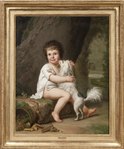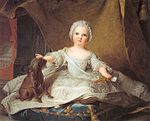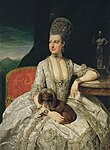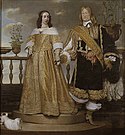Løwchen
| Löwchen | |
|---|---|
 | |
| Dansk navn | Løwchen |
| Andre navne | bichon petit chien lion |
| Hundetype | Selskabshund |
| Oprindelsesland/-område | Frankrig |
| Brugsegenskaber | Familiehund |
| Forventet livslængde | 12-16 år |
| Størrelse | Lille |
| Højde | 25-33 cm |
| Vægt | 5-8 kg |
| Racen egner sig til | de fleste |
| Gruppering | |
| FCI | Gruppe 9, sektion 1 |
| AKC | Non-Sporting |
| CKC | Group 6 (Non-Sporting) |
| KC | Toys |
| UKC | Companion Breeds |
| Hunderacer | |
Løwchen eller Löwchen (tysk: Löwchen "lille løve", fransk: Petit chien lion, "lille løve hund")[1] er en gammel hunderace, som var selskabshund for adelen og hoffet før den franske revolution. Den stammer fra Middelhavslandene og især Frankrig. Løveklipningen har bidraget til racens navn, som på fransk er Petit chien lion. Det er imidlertid det tyske racenavn Löwchen, som er mest kendt og brugt i store dele af verden. Efter 2. verdenskrig var det belgiske og tyske hunde, som lagde grunden til den moderne, planmæssige avl.[1] Den franske raceklub blev stiftet i 1947.
Historie
Portræt af Agnès Sorel (1422-1450) med lille hund i løveklip.
Hund i løveklip 1505
Bryllupsportræt af Magnus Gabriel De la Gardie og Maria Eufrosyne, 1653. Ved siden af, en lille hund i løveklip
Gammelt hollandske maleri af Adriaen van Utrecht, detalje af hunden
To-årige Henri Bertholet-Campan med sin hund i løveklip af Ulrik Wertmüller 1786
Hertuginde Katharina af Mecklenburg af Lucas Cranach den ældre malet 1514 med sin hund i løveklip
Portræt af prinsesse Marie Zéphyrine af Frankrig (1750-1755) med sin hund i løveklip
Ærkehertuginde Maria Christina, hertuginde af Teschen, (1742-1798) med sin hund i løveklip
Referencer
- ^ a b "Løwchen" [Löwchen]. nethundeguiden.dk. 2014. Arkiveret fra originalen 27. maj 2014. Hentet 2014-05-26.
Eksterne henvisninger
 | Wikimedia Commons har medier relateret til: |
- Klubben for Små Selskabshunde Arkiveret 24. september 2014 hos Wayback Machine
| ||||||||||||||||||||||
| Spire Denne hunderelaterede artikel er en spire som bør udbygges. Du er velkommen til at hjælpe Wikipedia ved at udvide den. |
|
Medier brugt på denne side
Silhouettes of a dog
New acquisition, July 2013:
Portrait by Adolf Ulrik Wertmüller
Nationalmuseum’s collection of Swedish-French paintings from the 18th century now includes a portrait of the two-year-old Henri Bertholet-Campan (1784-1821), painted by Adolf Ulrik Wertmüller. The boy was the son of Marie Antoinette’s First Lady of the Bedchamber Henriette Genet-Campan. The portrait depicts him with his dog Aline in the English landscape garden at the family’s summer house in Croissy outside Paris. The painting was exhibited at the Salon of 1787, but under the rather anonymous title of A child playing with a dog.
Adolf Ulrik Wertmüller (1751–1811) trained under his second cousin Alexander Roslin in Paris and studied at the French Academy in Rome. When Wertmüller returned to the French capital in spring 1781, he found it difficult to obtain work as a portraitist and instead earned his keep as a copyist at Roslin’s studio. Here he was discovered by the Swedish Ambassador Gustaf Filip Creutz, who made several important commissions. This in turn resulted in Gustav III convincing France’s Queen Marie Antoinette, during his stay in Paris in the summer of 1784, to let Wertmüller paint her portrait as a gift to the Swedish King. The portrait is currently held in the collections of Nationalmuseum.
King Gustav III had intended this to be Wertmüller’s ticket to a successful career in Paris, but jealousies abounded. When the portrait of Marie Antoinette was exhibited in August 1785, it was attacked by the critics. The Queen was also unimpressed. The artist fell into a deep depression, but recovered enough to make the necessary changes before the portrait was dispatched to Sweden the following year. It was Wertmüller’s friend Henriette Genet-Campan who came to his aid. The fact that Wertmüller even got paid was largely down to Mme Campan, since she managed the Queen’s purse and was intimately involved in the royal finances. For security reasons a mutual friend, Gabriel Lindblom, acted as a go-between in contact between the two. Lindblom had been governor to Mme Campan’s younger brother Edmond Genet and served as an interpreter at the French Ministry of Foreign Affairs in Versailles. This explains why Wertmüller was so well informed and why he came to paint almost a dozen portraits of various members of the Genet-Campan family.
As a show of gratitude to his friend Mme Campan, Wertmüller painted a portrait of her two-year-old son Henri in autumn 1786. He had already immortalised the child as a new-born baby and would continue to paint other relatives of Mme Campan. These include the portrait of her sister Adélaïde Auguié dressed as a milkmaid in the royal dairy at Petit Trianon-Le Hameau, painted in 1787. This painting has been part of the museum’s collection since 1951 as a gift from the Friends of Nationalmuseum. A study for the portrait of the French Crown Prince Louis has also since been purchased. Now this latest acquisition adds another piece to the fascinating puzzle of how Wertmüller came to paint his portrait of Queen Marie Antoinette.Detail aus dem Gemälde: Disput der hl. Katharina mit den Philosophen, um 1505–1510, Tempera auf Holz, Salzburg Museum, Inv. Nr. 25/72

















